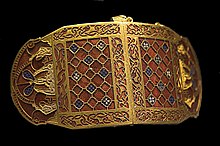English medieval clothing
The Medieval period in England is usually classified as the time between the fall of the Roman Empire to the beginning of the Renaissance, roughly the years AD 410–1485.
Clothes were very expensive, and both men and women were divided into social classes by regulating the colors and styles that various ranks were permitted to wear.
In the early Middle Ages, clothing was typically simple and, particularly in the case of lower-class peoples, served only basic utilitarian functions such as modesty and protection from the elements.
As time went on the advent of more advanced textile techniques and increased international relations, clothing gradually got more and more intricate and elegant, even with those under the wealthy classes, up into the renaissance.
The normal women's costume of this era was a long peplos-like garment, pulled up to the armpit and worn over a sleeved undergarment (usually another dress).
Basic garments now consisted of the smock, hose, kirtle, gown, belt, surcoat, girdle, cape, hood, and bonnet.
[13] The skirt was developed during this period, and quickly eclipsed the petticoat in both popularity and use;[13] [14] use of a headdress, in various forms, (culminating in the hennin) was now an important element too.
Other means of fastening the cloth together included tying, lacing, or using a clasp, often made of natural materials such as thorn, bones, wood, or horns.
Clasps were not needed to hold the tunic together because when pulled over the head it would sit snugly around the neck without the use of lacing or ties, indicating that the garment was one continuous piece.
Atop the stockings, rounds of cloth, linen, or leather were worn which started at the ankle and ended just below the knee, as Planché explains, in "close rolls.. or crisscrossing each other sandal-wise".
[28][37] Well-armed Anglo-Saxon soldiers wore wrap-over coats decorated like chain mail with sleeves that narrowed at the wrists, these were often embroiled with flowers or plants.
[41] Weapons and clothes fittings worn on the battlefield were highly decorated with jewelry techniques, as seen in the discoveries at Sutton Hoo and in the Staffordshire Hoard; the concept of parade wear did not exist for the Anglo-Saxons.
[42] Owen-Crocker mentions that their twill cloaks were generally shorter than those of the laity, reaching just below the waist, and Planché adds, that they wore linen stocking.
[45] These additions consisted of a spear, ax, sword, bow, shield, steel cap, helmet, an iron coat, or a linen or cloth tunic.
Previous mail tunics, found to be too heavy preventing the soldier from properly fighting, were replaced by the new leather armor, which consisted of overlapping flaps, cut like scales or leaves and each dyed a different color.
[50] The clergy of the 11th century had shaved heads and wore bonnets, which, according to Planché, were "slightly sinking in the center, with the pendent ornaments of the mitre attached to the side of it".
There was, as C. Willett and Phillis Cunnington describe, a "slit up in front to the thigh level" and the sleeves, now close fitting, were "bell-shaped" at the wrist or, the "lower portion [hung] to form a pendulous cuff which might be rolled up for action".
Longer stockings, mid thigh length, could also be worn: as C. Willett and Phillis Cunnington say, they were "shaped to fit the leg, widening above the knee so that they could be pulled up over the braies".
[55] Small hats with round crowns and, the Cunningtons say, "turned-down brim, decorated with a knob instead of a stalk" were also worn, as were coifs, which was a "close fitting plain linen bonnet which covered the ears and confined the hair" and tied under the chin.
Rings, brooches, buckles, clasps, and "ornamental fillets of gold and silver", according to the Cunningtons, were worn by the ruling classes.
A wide armhole, which extended to the waist, was left open and the sleeves were cut in order to, as the Cunningtons state, "slope off to a narrow tight cuff at the wrist".
Gloves continued to be worn by the nobility and could be long, stretching to the elbow, or short, wrist length, and began to be decorated, the Cunningtons explain, "with a broad strip of gold embroidery down the back as far as the knuckles".
Again, because of the cost the poor could not afford these and instead wore simple cloth veils called wimples that "draped over the head, around the neck and up to the chin".
This is evident in the sumptuary laws of 1327 which states "coming to the lowest class no serving man is to use 2½ yards in a short gown or 3 in a long one".
The medieval sumptuary laws or "acts of apparel" were put into place to regulate the clothing choices of people during that time.
[77] This clearly states the understood division between the rich and poor during this era, and the importance of keeping the classes defined as separate entities.
[79] The English sumptuary acts of 1363 go into explicit detail about clothing items which were reserved for those below the king's status, putting restrictions on coat length and shoe height.
[81] The acts depicted what clothing was to be worn and also clearly stated how the classes were ranked, with kings and royalty at the top and servants at the bottom.
This was because the middle class was considered most likely to violate the clothing laws because they were supposedly most influenced by social pressures, whereas lower-class people did not have the capabilities to dress according to a higher ranking even if they desired to do so.
The wealthy could afford to add elaborate designs to their clothing as well as dying it red and black, expensive colours for the time.









